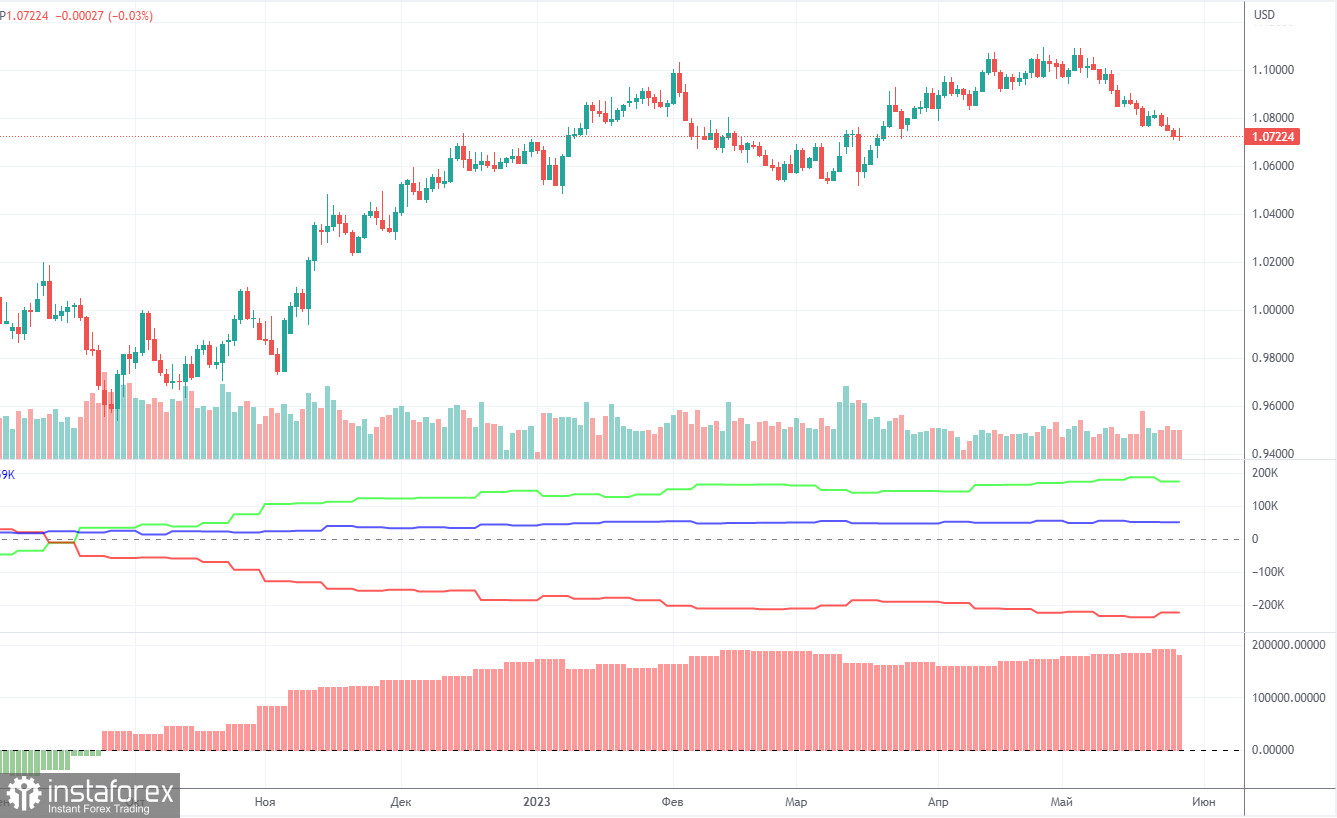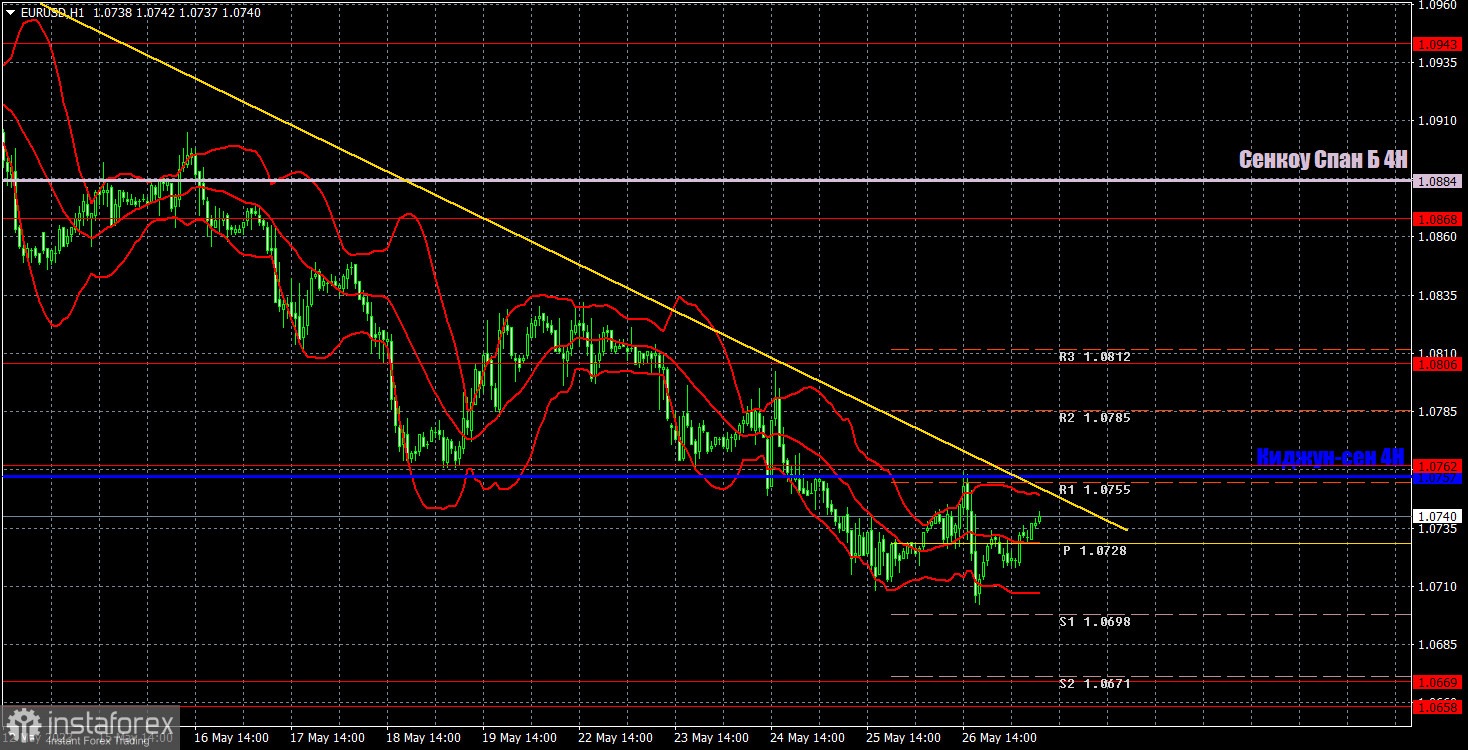M5 chart of EUR/USD

On Friday, EUR/USD was in a downtrend. Volatility totaled less than 60 pips. In the European session, the market was flat. In the American session, the pair went down after the release of macro data in the US. Of five published reports, only one provided support for the greenback. Durable goods orders came better than expected. So, any report of secondary importance may trigger a reaction if its results differ significantly from forecasts.
On Friday, just one signal came. The pair pulled back from 1.0762 and dropped by about 60 pips. However, it failed to touch the nearest target, and positions were closed manually by the end of the trading day. Profit totaled some 30-40 pips.
COT report:

The COT report for May 23 was delivered on Friday. Over the past nine months, COT data has been in line with developments in the market. The net position (second indicator on the chart) has been on the rise since September 2022. The euro started to show strength approximately at the same time. Currently, the net non-commercial position is bullish and keeps growing further. Likewise, the euro is bullish.
Notably, we may assume by the extremely bullish net position that the uptrend may soon stop. The first indicator shows that, and the red and green lines are far away from each other, which is usually a sign that the end of the trend might be nearing. The euro attempted to go down several months ago, but those were just minor pullbacks. In the reporting week, long positions of non-commercial traders decreased by 8,600 and short positions rose by 4,700. The net position dropped by 13,300. The number of long positions exceeds that of short ones by 174,000, a rather big gap. A correction or a new downtrend has started. So, it is clear that the pair will be bearish even without COT reports.
H1 chart of EUR/USD

In the 1-hour time frame, the pair is still moving down. The trend is clear. The trendline is relevant. The price is below the Ichimoku lines. Nevertheless, the pair loses some 20-30 pips every day. That is, the trend is strong despite a sluggish fall every day. So, trades can be held for several days at least.
On May 29, trading levels are seen at 1.0537, 1.0581, 1.0658-1.0669, 1.0762, 1.0806, 1.0868, 1.0943, 1.1092, 1.0884 ((Senkou Span B) and 1.0757 (Kijun-sen). Ichimoku indicator lines can move intraday, which should be taken into account when determining trading signals. There are also support and resistance although no signals are made near these levels. Signals could be made when the price either breaks or bounces from these extreme levels. Do not forget to place Stop Loss at the breakeven point when the price goes by 15 pips in the right direction. In case of a false breakout, it could save you from possible losses.
Today, the macroeconomic calendar of the EU and the US is empty. Therefore, we will unlikely see any strong intraday movements. There is a high likelihood of a flat market.
Indicators on charts:
Resistance/support - thick red lines, near which the trend may stop. They do not make trading signals.
Kijun-sen and Senkou Span B are the Ichimoku indicator lines moved to the hourly timeframe from the 4-hour timeframe. They are also strong lines.
Extreme levels are thin red lines, from which the price used to bounce earlier. They can produce trading signals.
Yellow lines are trend lines, trend channels, and other technical patterns.
Indicator 1 on the COT chart is the size of the net position of each trader category.
Indicator 2 on the COT chart is the size of the net position for the Non-commercial group of traders.
 English
English 
 Русский
Русский Bahasa Indonesia
Bahasa Indonesia Bahasa Malay
Bahasa Malay ไทย
ไทย Español
Español Deutsch
Deutsch Български
Български Français
Français Tiếng Việt
Tiếng Việt 中文
中文 বাংলা
বাংলা हिन्दी
हिन्दी Čeština
Čeština Українська
Українська Română
Română

